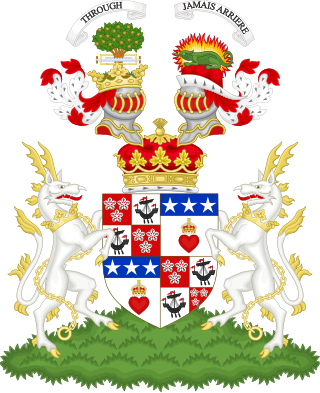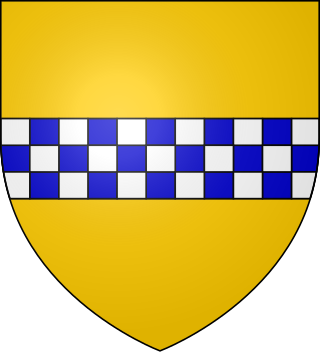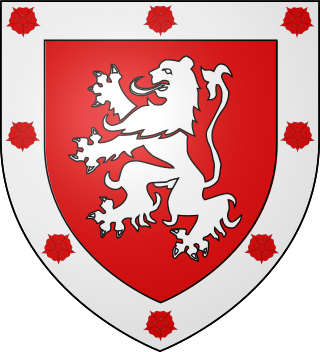Related Research Articles

Duke of Hamilton is a title in the Peerage of Scotland, created in April 1643. It is the senior dukedom in that peerage, and as such its holder is the premier peer of Scotland, as well as being head of both the House of Hamilton and the House of Douglas. The title, the town of Hamilton in Lanarkshire, and many places around the world are named after members of the Hamilton family. The ducal family's surname, originally "Hamilton", is now "Douglas-Hamilton". Since 1711, the dukedom has been held together with the Dukedom of Brandon in the Peerage of Great Britain, and the dukes since that time have been styled Duke of Hamilton and Brandon, along with several other subsidiary titles.

Earl of Elgin is a title in the Peerage of Scotland, created in 1633 for Thomas Bruce, 3rd Lord Kinloss. He was later created Baron Bruce, of Whorlton in the County of York, in the Peerage of England on 30 July 1641. The Earl of Elgin is the hereditary Clan Chief of Clan Bruce.

Henry Somerset, 2nd Earl of Worcester was an English nobleman. He was the son of Charles Somerset, 1st Earl of Worcester and Elizabeth Herbert, 3rd Baroness Herbert. On his father's death on 15 April 1526, he succeeded as the second Earl of Worcester. From his mother, he inherited the title of Baron Herbert.

Alexander Stewart, known as Alexander of Dundonald, was a Scottish magnate who in 1241 succeeded his father as hereditary High Steward of Scotland.
George Leslie, 4th Earl of Rothes was a Scottish nobleman and diplomat.
Mark Kerr, 1st Earl of Lothian was a Scottish nobleman and politician. He became the first Earl of Lothian in 1606.

William Henry Walter Montagu Douglas Scott, 6th Duke of Buccleuch and 8th Duke of Queensberry, was a Scottish Member of Parliament and peer. He was the paternal grandfather of Princess Alice, Duchess of Gloucester, as well as a maternal great-grandfather of Prince William of Gloucester and Prince Richard, Duke of Gloucester, and a great-great-grandfather of Sarah, Duchess of York.
William de Brus, 3rd Lord of Annandale, was the second but eldest surviving son of Robert de Brus, 2nd Lord of Annandale.

Lord Somerville is a title in the Peerage of Scotland which is subject to a number of ambiguities. The date of creation is not known with certainty but it was probably created about 1435 for Thomas Somerville, Justiciar of Scotland. The title was omitted in 1606 when an ordered list of the Scottish peerage was produced following the union of the Scottish and English crowns, and the title was not used during the 17th century. In 1723, however, the House of Lords ratified and acknowledged the title for James Somerville the 13th Lord. The consecutive numbers ascribed to the numerous Lords differ according to which authority is consulted. The list below uses the numbers favoured by Burkes Peerage.

Thomas Burgh, 1st Baron Burgh also spelt Borough, KG, 1st Baron Borough of Gainsborough, also de jure 5th Baron Strabolgi and 7th Baron Cobham of Sterborough, was an English peer. In 1513 he was knighted on Flodden Field, where he was one of the King's Spears, a bodyguard of King Henry VIII. He later became Lord Chamberlain to Anne Boleyn. He was also one of the twenty-six Peers summoned to the trial of Anne Boleyn in May 1536.

George de Dunbar, 10th Earl of Dunbar and March (1338–1422), 12th Lord of Annandale and Lord of the Isle of Man, was "one of the most powerful nobles in Scotland of his time, and the rival of the Douglases."

Lady Eleanor Beauchamp, Baroness de Ros and Duchess of Somerset was the second daughter of Richard de Beauchamp, 13th Earl of Warwick and Elizabeth de Berkeley, daughter of Thomas de Berkeley, 5th Baron Berkeley.

William Keith, 4th Earl Marischal was a Scottish nobleman and politician.
Hugh Somerville, 5th Lord Somerville was a lord of the Parliament of Scotland. He is sometimes reckoned to be the 4th Lord Somerville. He succeeded his brother, John Somerville, 4th Lord Somerville. Hugh and John were sons of William Somerville, Master of Somerville, and Marjory Montgomerie.
Thomas Somerville, 1st Lord Somerville,, was a Lord of the Parliament of Scotland.

William Hay, 1st Earl of Erroll was a Scottish peer. He was the first Earl of Erroll and the second Lord Hay of Erroll.

John Lindsay, 17th Earl of Crawford, 1st Earl of Lindsay was a Scottish nobleman.
Sir Claud Hamilton of Shawfield, PC (Ire), also called of Leckprevick, a younger son of Claud Hamilton, 1st Lord Paisley in Scotland, was a gentleman of the privy chamber of King James VI and I, an undertaker in the Plantation of Ulster, and a privy counsellor in Ireland.
John Lindsay, 8th Lord Lindsay PC, was a Scottish landowner.
Robert Lindsay, 9th Lord Lindsay PC, was a Scottish landowner.
References
- Burke, Bernard. A Genealogical History of the Dormant, Abeyant, Forfeited, and Extinct Peerages of the British Empire, new edition (1883; reprint, Baltimore, Maryland: Genealogical Publishing Company, 1978)
- Douglas, Robert. The peerage of Scotland: containing an historical and genealogical account of the nobility of that kingdom, ... collected from the public records, and ancient chartularies of this nation, ... Illustrated with copper-plates.